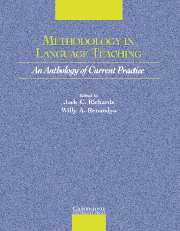Book contents
- Frontmatter
- Contents
- Acknowledgments
- Introduction
- Section I Approaches to Teaching
- Section 2 Lesson Planning and Classroom Management
- Chapter 3 Lesson Planning
- Chapter 4 Classroom Management
- Section 3 Classroom Dynamics
- Section 4 Syllabus Design and Instructional Materials
- Section 5 Task and Project Work
- Section 6 Learning Strategies
- Section 7 Teaching Grammar
- Section 8 Teaching Pronunciation
- Section 9 Teaching Speaking
- Section 10 Teaching Listening
- Section 11 Teaching Vocabulary
- Section 12 Teaching Reading
- Section 13 Teaching Writing
- Section 14 Assessment
- Section 15 Technologies in the Classroom
- Section 16 Professional Development
- Credits
- Author Index
- Subject Index
- References
Chapter 3 - Lesson Planning
Published online by Cambridge University Press: 10 November 2010
- Frontmatter
- Contents
- Acknowledgments
- Introduction
- Section I Approaches to Teaching
- Section 2 Lesson Planning and Classroom Management
- Chapter 3 Lesson Planning
- Chapter 4 Classroom Management
- Section 3 Classroom Dynamics
- Section 4 Syllabus Design and Instructional Materials
- Section 5 Task and Project Work
- Section 6 Learning Strategies
- Section 7 Teaching Grammar
- Section 8 Teaching Pronunciation
- Section 9 Teaching Speaking
- Section 10 Teaching Listening
- Section 11 Teaching Vocabulary
- Section 12 Teaching Reading
- Section 13 Teaching Writing
- Section 14 Assessment
- Section 15 Technologies in the Classroom
- Section 16 Professional Development
- Credits
- Author Index
- Subject Index
- References
Summary
“Would you tell me, please, which way I ought to go from here?” asked Alice.
“That depends a good deal on where you want to get to,” said the Cheshire Cat.
Lewis Carroll (1963). Alice's Adventures in Wonderland (p. 59). New York: Macmillan.INTRODUCTION
Teachers may wonder “which way they ought to go” before they enter a classroom. This usually means that teachers need to plan what they want to do in their classrooms. Most teachers engage in yearly, term, unit, weekly, and daily lesson planning (Yinger, 1980). Yearly and term planning usually involve listing the objectives for a particular program. A unit plan is a series of related lessons around a specific theme such as “The Family.” Planning daily lessons is the end result of a complex planning process that includes the yearly, term, and unit plans. A daily lesson plan is a written description of how students will move toward attaining specific objectives. It describes the teaching behavior that will result in student learning.
This chapter addresses the daily planning decisions that English language teachers make before they enter the classroom. Included in this discussion are the interactive and evaluative decisions teachers make during and after the lesson. Richards (1998) stresses the importance of lesson planning for English language teachers: “The success with which a teacher conducts a lesson is often thought to depend on the effectiveness with which the lesson was planned” (p. 103).
- Type
- Chapter
- Information
- Methodology in Language TeachingAn Anthology of Current Practice, pp. 30 - 39Publisher: Cambridge University PressPrint publication year: 2002
References
- 20
- Cited by

